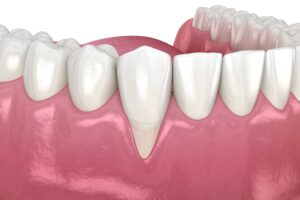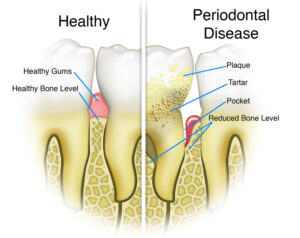Why are My Gums Receding?
 Gum recession is a problem. It affects the cosmetic appearance of your smile, it can make the teeth super sensitive, and it might indicate progressive gum disease. There are actually several different causes of receding gums. You may have one or multiple causes of your gum recession. Understanding the cause is essential to getting the right preventive treatment.
Gum recession is a problem. It affects the cosmetic appearance of your smile, it can make the teeth super sensitive, and it might indicate progressive gum disease. There are actually several different causes of receding gums. You may have one or multiple causes of your gum recession. Understanding the cause is essential to getting the right preventive treatment.
This article will explain the various causes of gum recession and how you can address them. You will need a consultation with Dr. Ann to get a correct diagnosis of the cause and degree of your recession. Then you can discuss treatment options.
Teeth Clenching and/or Grinding (Bruxism)
One of the most common but lesser known causes of gum recession is heavy forces on the teeth. Typically, these forces come in the form of clenching and/or grinding, which we refer to as bruxism. The teeth and the tissues surrounding them can withstand the normal forces of chewing. When we put heavier than normal forces on them, we can cause damage to both the teeth and these surrounding tissues.
The gums are relatively delicate and do not withstand heavy clenching or grinding forces well. In response, they may pull away from the force or recede. This becomes very obvious when a tooth receives more force than others around it. When we see an unusual amount of gum recession on a single tooth, a bite analysis often shows this tooth receiving more bite force than its neighbors do. The same goes for a rotated or misplaced tooth. If it receives a force at an unusual angle, this can cause gum recession. The great news is that these problems are easily addressed with some bite adjustment.
For overall gum recession in a heavy clencher or grinder, a hard acrylic nightguard is the best preventive treatment. By wearing a nightguard, you are separating the teeth and protecting the gums from receiving those heavy forces.
Improper Toothbrushing Techniques
As we just mentioned, the gum tissues around the teeth are relatively delicate. They will retreat from improper forces of several kinds, including the wrong type of brushing. Wrong toothbrushing techniques can include both the type of toothbrush you use and the way you use it.
It is essential to use only a soft or very soft bristled toothbrush. No one should use medium or hard bristles! Not even on a denture! They are too abrasive for plastic, acrylic, gums, and enamel. Using a hard toothbrush over time will cause the gums to recede and the tooth structure to wear away.
Using the toothbrush with the wrong technique can also lead to gum recession. Many people use heavy force to press the brush into the teeth, supposing that pushing harder will remove more plaque. You will definitely remove dental plaque, but you could remove your gum tissue as well. Dental plaque is soft, and you only need a gentle, circular motion to remove it.
Wondering if you brush too hard? Try the new Zentflex toothbrush, which features a joint in the handle that “breaks” when you start to press too hard.
Progressive Gum Disease
 Gum disease is a chronic bacterial infection of the tissues surrounding the teeth. As the body responds to the toxins produced by the bacteria, the inflammatory response becomes chronic. Chronic inflammation is NOT good. It leads to destruction of the tissues.
Gum disease is a chronic bacterial infection of the tissues surrounding the teeth. As the body responds to the toxins produced by the bacteria, the inflammatory response becomes chronic. Chronic inflammation is NOT good. It leads to destruction of the tissues.
As gum disease gets worse and worse, it destroys the surrounding bone and gums. This is an obvious and serious cause of gum recession. This loss of gum tissues results in a loss of support for the teeth. When the teeth do not have a solid foundation surrounding them, you lose chewing force and suffer problems like bad breath, sensitivity, and loose teeth.
In order to protect the gums, you must treat gum disease. The first step is removing the bacterial infection through professional gum treatments. Call today to schedule a visit with one of our wonderful dental hygienists to begin your journey to healthy gums.
Bad Positioning of the Teeth
Another important cause of gum recession is an improper positioning of the teeth. This can apply to a single tooth that has a position outside of the dental arch, or it can apply to the entire arch of teeth. In order for teeth to be surrounded by healthy jawbone and gum tissues, they must be located near the center of the ridge of jawbone.
We often see isolated cases of gum recession on a single tooth when the teeth have lots of crowding. The crowding pushes a tooth outside the line of the bone, and its outward position leads to a lack of coverage on that side.
Gum recession can occur on all of the teeth in a dental arch when orthodontic treatment pushes all of the teeth outward in an effort to widen the smile. A wide smile is always beautiful. The problem is that it may not have bone in the right place to support it! Any form of orthodontic treatment should always take the health and position of the underlying jawbone into consideration. With Dr. Ann’s experience of hundreds of successful Invisalign cases, you will get the beautiful smile you want along with the healthy, supporting jawbone you need.
More Questions about Gum Recession?
Call Designer Smiles today to schedule a consultation with Dr. Ann. She will assess the health of your gum tissues and the underlying cause of any recession. Then you can discuss your treatment options to prevent worsening and repair the problem areas.
